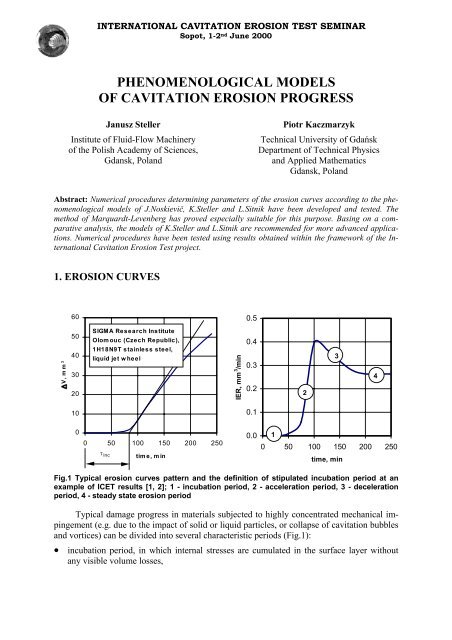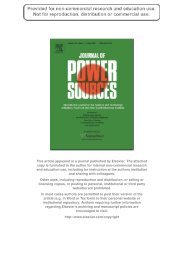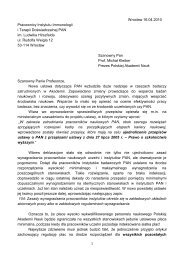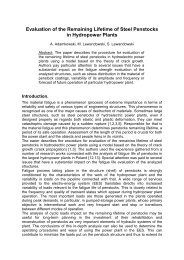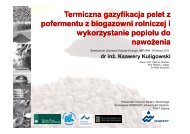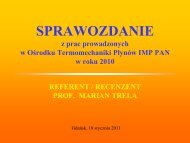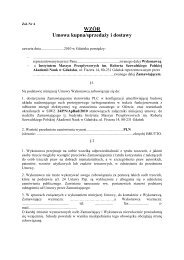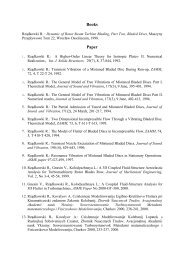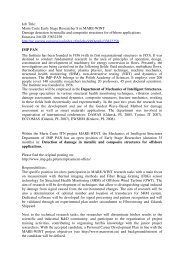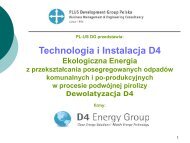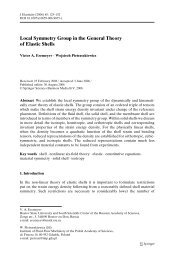Phenomenological models of cavitation erosion kinetics
Phenomenological models of cavitation erosion kinetics
Phenomenological models of cavitation erosion kinetics
- No tags were found...
Create successful ePaper yourself
Turn your PDF publications into a flip-book with our unique Google optimized e-Paper software.
INTERNATIONAL CAVITATION EROSION TEST SEMINARSopot, 1-2 nd June 2000PHENOMENOLOGICAL MODELSOF CAVITATION EROSION PROGRESSJanusz StellerInstitute <strong>of</strong> Fluid-Flow Machinery<strong>of</strong> the Polish Academy <strong>of</strong> Sciences,Gdansk, PolandPiotr KaczmarzykTechnical University <strong>of</strong> GdańskDepartment <strong>of</strong> Technical Physicsand Applied MathematicsGdansk, PolandAbstract: Numerical procedures determining parameters <strong>of</strong> the <strong>erosion</strong> curves according to the phenomenological<strong>models</strong> <strong>of</strong> J.Noskievič, K.Steller and L.Sitnik have been developed and tested. Themethod <strong>of</strong> Marquardt-Levenberg has proved especially suitable for this purpose. Basing on a comparativeanalysis, the <strong>models</strong> <strong>of</strong> K.Steller and L.Sitnik are recommended for more advanced applications.Numerical procedures have been tested using results obtained within the framework <strong>of</strong> the InternationalCavitation Erosion Test project.1. EROSION CURVES600.5V, mm 350403020SIGMA Research InstituteOlomouc (Czech Republic),1H18N9T stainless steel,liquid jet wheelIER, mm 3 /min0.40.30.2234100.100 50 100 150 200 2500.010 50 100 150 200 250τ inctime, mintime, minFig.1 Typical <strong>erosion</strong> curves pattern and the definition <strong>of</strong> stipulated incubation period at anexample <strong>of</strong> ICET results [1, 2]; 1 - incubation period, 2 - acceleration period, 3 - decelerationperiod, 4 - steady state <strong>erosion</strong> periodTypical damage progress in materials subjected to highly concentrated mechanical impingement(e.g. due to the impact <strong>of</strong> solid or liquid particles, or collapse <strong>of</strong> <strong>cavitation</strong> bubblesand vortices) can be divided into several characteristic periods (Fig.1):• incubation period, in which internal stresses are cumulated in the surface layer withoutany visible volume losses,
4 International Cavitation Erosion Test Seminar, Sopot, 1-2 June 2000where the expression under the integral sign denotes <strong>erosion</strong> rate at the surface element uncoveredin the instant T.F.J.Heymann states that realistic <strong>erosion</strong> curves can be obtained by assuming the f(t)function to vanish in the initial period <strong>of</strong> exposure (t ≤ T 0 ), and then to be described by athree-parameter logarithmic-normal distribution[ ln( t − T ) − m]21 ⎪⎧−⎪⎫0f () t = exp⎨2 ⎬(2)σ ( t − T0 ) 2π⎪⎩ 2σ⎪⎭For the original surface layer F.J.Heymann proposes to use a distribution with parametersdifferent from those applied for the subsequent layers. However, there are no hints on themethod <strong>of</strong> their determination to be found in reference [4].Later on, J.Noskievič [5] and K.Steller [6] proposed <strong>models</strong> <strong>of</strong> <strong>erosion</strong> <strong>kinetics</strong> referringdirectly to the <strong>erosion</strong> curve pattern.J.Noskievič has noticed that the instantaneous <strong>erosion</strong> rate curve, IER =IER(t) remindsthat <strong>of</strong> damped harmonic oscillator motion. The equation <strong>of</strong> motion <strong>of</strong> such an oscillator canbe written asd2( IER) d( IER)dt22+ 2α + β IER = I . (3)dtwith α and β denoting coefficients responsible for material properties (α - work-hardeningcapability, β - <strong>cavitation</strong> resistance), and I - parameter characterising intensity <strong>of</strong> <strong>cavitation</strong>erosive activity (I = const). By assuming <strong>erosion</strong> rate and its first derivative to vanish at thebeginning <strong>of</strong> the process, the solution <strong>of</strong> equation (3) can be written down as−κtκt[( α −κ) e − ( α + κ ) e ]−αt⎧ e⎪vs+ vs⎪2κ−αt⎪vs− vs( 1+α2t)eIER()t = ⎨⎪ ⎛ α ⎞vs− vs⎜cosωt− sinωt⎟e⎪ ⎝ ω ⎠⎪⎩vs− vscosωt−αtififififα > βα = ± βα < βα = 0andα ≠ 0, (4)2 22where κ = α − β and ω = β −α2 , whence the volume loss curve is given by:∆V= vs−αt⎡ α e ⎛α+ κ kt α −κ−kt⎞⎤⎢t− 2 + ⎜ e − e ⎟⎥⎣ β 2if ⏐α⏐ > β (5a)2κ⎝α−κα + κ ⎠⎦∆ V= vs⎡ 2 ⎛ 2 ⎞⎢t− + ⎜t+ ⎟e⎣ α ⎝ α ⎠−αt⎤⎥⎦if α =±β(5b)⎧ α α t ⎡⎛⎞⎤⎫−αα ω∆V = vs⎨t− 2 2+ 2e ⎢⎜− ⎟ sin ωt+2 cosωt⎣⎝⎠⎥⎬,⎩ β β ω α⎦⎭if ⏐α ⏐< β and α ≠ 0 (5c)⎞⎜1∆V= v − s t ω t ⎟⎝ ω sin ,⎠if α = 0 (5d)
J.Steller, P.Kaczmarzyk: <strong>Phenomenological</strong> <strong>models</strong> <strong>of</strong> <strong>cavitation</strong> <strong>erosion</strong> progress. 5The formula proposed by K.Steller is based on the notion <strong>of</strong> <strong>cavitation</strong> resistance R cav ,clearly linked to that <strong>of</strong> A.P.Thiruvengadam's <strong>erosion</strong> strength [7] and defined by the equation:Pt = R cav ∆V (6)where P is the power used to erode the material subject to <strong>cavitation</strong> impingement. Cavitationis assumed a continuous process (proceeding at variable speed) resulting in the change <strong>of</strong> bothmaterial surface and its internal structure, responsible for <strong>cavitation</strong> resistance. Cavitationresistance dependence on duration <strong>of</strong> <strong>cavitation</strong> impingement is assumed to be described byan exponentially decreasing functionThe formula derivedRcav( 1+χ )−κtχ + e=1 R 0χ +Pt2 1≈σ∆V=−κt2R0( χ + e )( + χ )EPt−κt( χ + e )shows clear dependence <strong>of</strong> the volume loss curve ∆V = ∆V(t) on some basic material parameters(modulus <strong>of</strong> elasticity E and ultimate stress values σ), χ factor determining the ratio <strong>of</strong>ultimate and initial <strong>cavitation</strong> resistance (equation (7)), κ parameter defining the speed <strong>of</strong><strong>cavitation</strong> resistance decrease in course <strong>of</strong> the process and power P used to erode the material.In mid eighties L.Sitnik [8] assumed the time interval ∆t between removal <strong>of</strong> the consecutiveparticles from the material surface to be a random function with a three-parameterlogarithmic-natural distribution functionThe volume loss curve derived takes the formFpβ p{ }( ∆t) = 1 − − α [ ln ( ∆t∆t0 + 1)]p(7)(8)exp . (9)β p[ ( t ∆t∆V= α ∆Vln 1)]p0 0 +with ∆V 0 denoting certain characteristic volume value. The α p parameter is characteristic forthe intensity <strong>of</strong> erosive action <strong>of</strong> the phenomenon. It is worthwhile to notice that the model isa simplified version <strong>of</strong> the F.J.Heymann model.(10)3. DETERMINING THE VOLUME LOSS CURVE PARAMETERSACCORDING TO THE SELECTED MODELSOF CAVITATION EROSION KINETICSThe least squares method has been adopted in order to determine the volume loss parametersaccording to selected <strong>models</strong>. The task can be reduced to that <strong>of</strong> minimising the expression2[=∑α∆V−χ ( k)U kjjj( , t )]with α j denoting the weight coefficient, U( . , t) - a function describing <strong>erosion</strong> progress accordingto the model selected, and k - a set (vector) <strong>of</strong> parameters to be determined by means<strong>of</strong> the minimising procedure.During calculations <strong>of</strong> that kind particular attention should be brought to an appropriateselection <strong>of</strong> the zero-th approximation.j2,(11)
6 International Cavitation Erosion Test Seminar, Sopot, 1-2 June 2000In case <strong>of</strong> the J.Noskievič model the α = ±β or α = 0 condition is assumed in the zerothapproximation. Developing expressions (5b) and (5d) into a Mc Laurin series yields:2 3 3 4⎛αt α t ⎞3 4U ( k , t) ≈ u ⎜⎟s − = at + bt6 12if α = ±β (12a)⎝⎠⎛ 1 2 3 1 4 5 ⎞ 3 5U ( k , t) = us ⎜ ω t − ω t + ... ⎟ ≈ at + bt if α = 0 (12b)⎝ 6 120 ⎠Parameters occurring in the formulae above can be easily determined by means <strong>of</strong> a linearregression. The formula resulting in the smaller value <strong>of</strong> the χ 2 parameter is selected as zerothapproximation for the minimising procedures.In case <strong>of</strong> the K.Steller model the χ = 0 condition is assumed in the zero-th approximationand parameter κ is determined from the approximate formula [7]∆VTT− 2 ∆Vdt30κ =, (13)T ∆VTwith T denoting the total exposure duration <strong>of</strong> the material, and ∆V T – total volume loss correspondingto this period. Sufficient accuracy is attained when using the trapezoid method <strong>of</strong>integration. The geometrical interpretation <strong>of</strong> expression (13) is explained in reference [7].In case <strong>of</strong> the L.Sitnik model ∆t 0 = τ inc condition is assumed in the zero-th approximationwhile α and β parameters are determined from the linear regression <strong>of</strong> the[T(T∫ln U = a+ bln ln t ∆t0+ 1)] (14)function with a = lnα and b = β. The zero-th approximation <strong>of</strong> the ∆t 0 = τ inc parameter is determinedby approximating the volume loss curve with the (12a) binomial.The following minimisation procedures described in the excellent monograph byW.H.Press et al. [8] have been selected:• the simplex method (comparison <strong>of</strong> values at the tops <strong>of</strong> a simplex constructed in thespace <strong>of</strong> parameters, followed by its reflections, contractions and elongations in the directiondetermined by the minimum value <strong>of</strong> the minimised function)• the Powell method (a non-gradient minimisation method along the basic vectors withconfiguration modified in subsequent steps)• the Levenberg-Marquardt (combination <strong>of</strong> the steepest slope method with that <strong>of</strong> reversedhessian by scaling the diagonal <strong>of</strong> the Hessian matrix)Application <strong>of</strong> some other methods, including those <strong>of</strong> the steepest slope, conjugategradients in the Fletcher-Reeves or Polak-Ribier version, reversed Hessian (generalised Newtonmethod) and the BFGS method <strong>of</strong> variable metrics was also considered in the initial stage<strong>of</strong> developing the appropriate numerical code.
J.Steller, P.Kaczmarzyk: <strong>Phenomenological</strong> <strong>models</strong> <strong>of</strong> <strong>cavitation</strong> <strong>erosion</strong> progress. 74. NUMERICAL CODE TO CALCULATE PARAMETERSOF EROSION CURVESAND THE ANALYSIS OF OBTAINED RESULTSA computer code APROX [9] has been developed in the Borland Pascal language in orderto accomplish the necessary calculations. The code enables approximation <strong>of</strong> mass, volumeand mean depth <strong>of</strong> penetration curves following the <strong>models</strong> described in section 2, usingone <strong>of</strong> the above mentioned minimisation methods. The curves <strong>of</strong> instantaneous and cumulative<strong>erosion</strong> rate and basic single-number parameters are also determined. In case <strong>of</strong> severalspecimens the code determines also the averaged curves and parameters. A hard copy <strong>of</strong> thecomputer screen, taken during processing <strong>of</strong> the E04 data at the IMP PAN rotating disk canbe seen in Fig.4.Fig.4 A hard copy <strong>of</strong> the computer screen, taken during processing the E04 dataThe analysis conducted has proved very good convergence <strong>of</strong> all the methods in casethe process under consideration covers also the period <strong>of</strong> steady or quasi-steady damage rate(Fig.5a).The evident superiority <strong>of</strong> the simplex and Levenberg-Marquardt methods over that <strong>of</strong>Powell was stated already in the early stage <strong>of</strong> analysis. Currently, no problems occur whencalculating the <strong>erosion</strong> curves according to the <strong>models</strong> <strong>of</strong> K.Steller and L.Sitnik. Calculationby means <strong>of</strong> the simplex method does not always end in global minimisation <strong>of</strong> formula (11).
8 International Cavitation Erosion Test Seminar, Sopot, 1-2 June 2000∆V, mm 3∆V, mm 320018016014012010080604020IMP PAN (RD) 1H18N9TStellerNoskievic, Sitnik00 200 400 600 800 1000 12005040302010Stellerczas, minIMP PAN (RD) 1H18N9TNoskievicSitnik00 100 200 300 400 500czas, minFig.5 Erosion curves obtained at the IMP PAN rotatingdisk facility (the exposure period <strong>of</strong> 20 h duration isanalysed)∆V, mm 35040302010IMP PAN (RD) 1H18N9TSitnikNoskievicSteller00 100 200 300 400czas, minFig.6 Erosion curves obtained at the IMP PAN rotatingdisk facility (the exposure period <strong>of</strong> 6 h duration isanalysed)The work on ensuring full reliability<strong>of</strong> calculations according tothe J.Noskievič model is now in progressand is expected to end successfullyin a short time. Neverthelessthe authors are reluctant to recommendit as an element <strong>of</strong> more sophisticatedalgorithms due to a rathercomplicated form <strong>of</strong> formula (5),incorporating additionally some periodicalfunctions.No numerical problems havebeen encountered when testing themodel <strong>of</strong> K.Steller. However, oneshould notice the non-vanishing firstderivative <strong>of</strong> formula (7) at the beginning<strong>of</strong> the process, which canresult in improper modelling <strong>of</strong> theincubation period and improper assessment<strong>of</strong> the maximum instantaneous<strong>erosion</strong> rate (Fig.5b). On theother hand side, if the analysis isconfined to the period precedingattainment <strong>of</strong> the maximum cumulative<strong>erosion</strong> rate (CER max ), the modelcan describe the reality even betterthan the other ones (Fig.6)Following the model <strong>of</strong>L.Sitnik, the <strong>erosion</strong> rate in the initialstage <strong>of</strong> damage is always equalzero. The curves obtained show avery smooth pattern, hardly dependenton the duration <strong>of</strong> analysed period.Therefore, under some circumstances,the model can describe materialperformance in the initial damageperiod worse than the other ones.An obvious advantage is the veryfact that the model has been developedbasing on considerations <strong>of</strong> thestochastic nature <strong>of</strong> the <strong>cavitation</strong><strong>erosion</strong> phenomenon. Thus, themodel is a continuation <strong>of</strong> the originalconcept <strong>of</strong> F.J.Heymann, somehowrelated to the contemporarymethods <strong>of</strong> modelling the fatiguephenomena [11].
J.Steller, P.Kaczmarzyk: <strong>Phenomenological</strong> <strong>models</strong> <strong>of</strong> <strong>cavitation</strong> <strong>erosion</strong> progress. 9REFERENCES1. Steller J.: International Cavitation Erosion Test. Preliminary Report. Part I: Coordinator'sReport. IMP PAN Int. Rep. no. 19/19982. Steller J.(ed.): International Cavitation Erosion Test. Preliminary Report. Part II: ExperimentalData. IMP PAN Int. Rep. no. 20/19983. Steller J.: International Cavitation Erosion Test and quantitative assessment <strong>of</strong> materialresistance to <strong>cavitation</strong>. Wear, Vol.233-235, December 1999, pp.51-644. Heymann F.J.: On the time dependence <strong>of</strong> the rate <strong>of</strong> <strong>erosion</strong> due to impingement or <strong>cavitation</strong>.[in:] "Erosion by Cavitation or Impingement", A symposium presented at the 69 thAnnual Meeting, ASTM, Atlantic City, 1966. ASTM Special Technical Publicationno.408, pp.70-1005. Noskievič J.: Dynamics <strong>of</strong> the <strong>cavitation</strong> damage, Joint Symposium on Design and Operation<strong>of</strong> Fluid Machinery, ASCE/IAHR/ASME, Colorado State University, Fort Collins,June 1978, pp.453-4626. Steller K.: Nowa koncepcja oceny odporności materiału na erozję kawitacyjną.Prace IMP, z.76, 1978, s.127-1507. Thiruvengadam A.P.: The concept <strong>of</strong> <strong>erosion</strong> strength. Erosion by <strong>cavitation</strong> or impingement[in:] "Erosion by Cavitation or Impingement", A symposium presented at the 69 thAnnual Meeting, ASTM, Atlantic City, 1966. ASTM Special Technical Publicationno.408, pp.22-358. Sitnik L.: Mathematical description <strong>of</strong> the <strong>cavitation</strong> <strong>erosion</strong> process and its utilizationfor increasing the materials resistance to <strong>cavitation</strong>. [in:] "Cavitation in Hydraulic Structuresand Turbomachinery". The Joint ASCE/ASME Mechanics Conf., Albuquerque,New Mexico, 1985, pp.21-309. Press W.H., Teukolsky S.A., Vetterling W.T., Flannery B.P.: Numerical Recipes in FOR-TRAN 77. The Art <strong>of</strong> Scientific Computing. Cambridge University Press, 199210. Kaczmarzyk P.: Kinetics <strong>of</strong> the <strong>cavitation</strong> <strong>erosion</strong> process in view <strong>of</strong> the InternationalCavitation Erosion Test results (in Polish). MSc Thesis, Faculty <strong>of</strong> Technical Physicsand Applied Mathematics, Technical University <strong>of</strong> Gdansk, Gdansk, 2000(under preparation)11. Sobczyk K., Spencer B.F.: Stochastyczne modele zmęczenia materiałów,WNT, Warszawa, 1996AuthorsDr Janusz StellerInstytut Maszyn Przepływowych PANul. Gen. J. Fiszera 1480-952 Gdańsk, Polandphone: +48 58 341 12 71 ext. 139e-mail: steller@imp.pg.gda.plPiotr KaczmarzykPolitechnika GdańskaWydział Fizyki Techniczneji Matematyki Stosowanej,ul. G. Narutowicza 1180-952 Gdańsk, Poland


